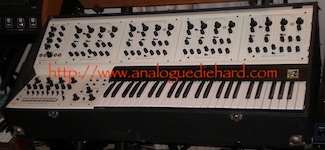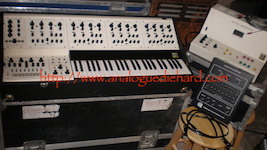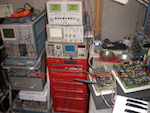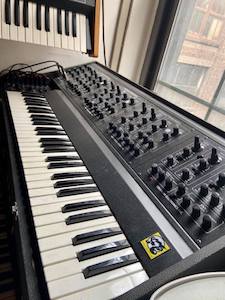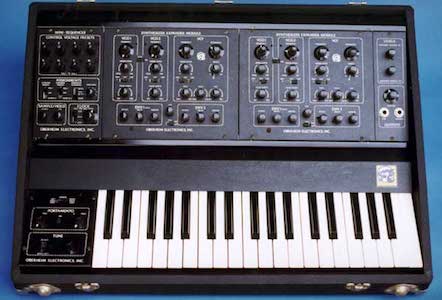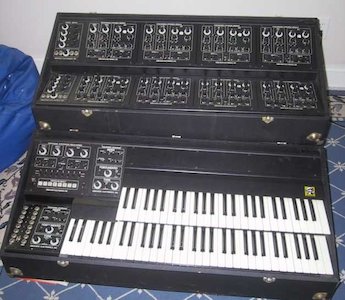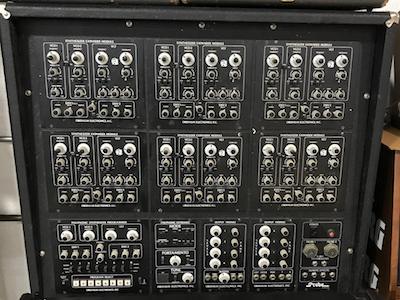Oberheim FVS Four Voice System Analog Polyphonic Synthesizer
Last Update
02-05-2021
This handyman’s specimen landed in my lap as part of a trade deal
with a studio owner. A friend of his gave up the tour
lifestyle and gave his Oberheim Four Voice Synthesizer (FVS) to the
studio owner, but it didn’t work at all. He sent it to my tech
friend, who found it beyond his skills. To be fair, the
schematics that are available are pretty poor. My tech friend
knew of my restoration success with Oberheims so he gave my name to
the studio owner. I managed to get it to make sound so I could
access what works and what doesn’t. It needed a LOT of work,
more than the studio owner was willing to invest. So he
offered it as a trade for one of my vintage keyboards. I could
have pointed him to a new reissue but he insisted on vintage, so I
had a dead Memorymoog I bought from a friend that I offered to
restore to full functionality in trade. I delivered, and I had
a FVS and a DS-2A sequencer both with Anvil road cases (which needed
new foam). I knew the Memorymoog would be much more user
friendly to the studio owner.
The backup battery - over forty years old - had leaked and damaged
some components and circuit board traces. My tech friend had
already removed the battery, and I neutralized the acidic corrosion
of the leakage to prevent further damage to the circuit board
traces. The keyboard controller and programmer needed some
real help. I spotted many 1st generation RCA CMOS logic ICs
that are notorious for dying in legacy Oberheims, as well as 1458,
LM301, and LM324 opamps that aren’t any better. Luckily the
not-available-at-any-price concentric ball bearing reduction VCO
tuning pots were fine, and some SEM malfunctions were easily
remedied with new regulators and opamps. I managed to
partially restore the keyboard controller, so with all SEMs working
I had a working FVS sans programmer (whose extensive repairs would
be addressed later).
The FVS has been a popular item at various AHMW events, where
synthesizer enthusiasts bring their vintage and modern synthesizers
for show and tell. There were a couple of FVS units brought by
members in the past, but mine was the first one that wasn’t DOA.
Polyphony
& Programmabilty - Tough Nut To Crack
The Oberheim Four Voice Synthesizer (FVS) is not the first
polyphonic synthesizer; but it was the first one that
mattered. In the 1970s, monophonic synthesizers were the
rage. But they could only play one note and musicians longed
for a synthesizer that could play chords. Polyphonic
synthesizers back in the 1970s were a tough nut to crack, and
varying designs did not always meet what the musicians wanted.
To be fair, there was a communication gap. Few musicians could
translate what they wanted into terms that synthesizer designers
could understand. The university intelligentsia were not much
help either. It was really an empirical process until gold was
struck.
To establish convention in this discussion: “voice” is a unique
pitched source; “note” is a key pressed on a keyboard.
Initial polyphonic synthesizer designs featured paraphonic systems;
despite the number of voices, a single voltage controlled filter
(VCF) covered the instrument. Some designs were a monophonic
synth with a keyboard that could produce two pitch CVs per VCO but
the remaining VCF, VCA, EG, LFO was shared between the two
voices. Not terribly flexible, could not play chords with more
than two notes. Some designs were a top octave divide-down
system similar to electronic organs, either with single VCF or none
at all. Although every note produced a voice the sole VCF,
lack of individual articulation (IE variable envelopes per voice),
and lack of wave shaping was very limiting. Usually these were
pre-configured string machines. None of these comprised what
the musicians wanted in a polyphonic synthesizer. The idea was
floated about bunching individual synthesizer voices under the
control of a keyboard, but the missing technology was a polyphonic
keyboard controller and a programmer.
Tom Oberheim had a good business going building guitar pedals for
the Norlin conglomerate under the Maestro brand; Norlin also owned
Gibson guitars, Pearl drums, Lowrey Organs, Moog Synthesizers, and
other well known music brands. Oberheim was also an ARP dealer
on the west coast which gave him his first exposure to analog
synthesizers - and plenty of interfacing with customers.
Customers desired a sequencer for their ARP products; Oberheim had
design experience with NCR corporation which built cash registers,
so he designed the DS-2 (later DS-2a with double the memory)
sequencer to meet their demand.
The DS-2a sequencer was a successful product. Oberheim noticed
that when customers interfaced the DS-2a to their synthesizer, they
couldn’t play on it any more. So Oberheim designed the SEM
module (Synthesizer Expansion Module) as an accessory for the
DS-2a. The SEM was a compact fully equipped analog synthesizer
voice without a keyboard that could be interfaced to the DS-2a so
the customer could still play along with the sequence playing on the
DS-2a. Tom Oberheim’s expertise was in logic design, so he
employed Jim Cooper (later of JLCooper products) as his analog
designer, and consulted with Dave Rossum of Emu on design
advice. Back in those days the collaboration between
synthesizer companies on the west coast was generally friendly (with
some exceptions), and Emu negotiated a royalty agreement based on
the sale of SEMs in exchange for consulting services.
Tom Oberheim never thought of his business as anything other than an
accessory maker - until there was a slump in the musical instrument
market. This slump caused Norlin/Maestro to cancel orders for
Oberheim’s products - Tom had to come up with a product that could
produce revenue, and fast.
Tom was aware of efforts to build polyphonic synthesizers, and from
his customers who bought ARP synthesizers he learned what they
wanted. By this time, Dave Rossum and Scott Wedge of Emu had
built their polyphonic keyboard controller for their modular
systems. Tom saw this as the ideal controller to pair up with
his SEMs. His idea was to bunch together multiple SEMs then
control them with Emu’s polyphonic controller. So a royalty
agreement was negotiated to use Emu’s design, and the FVS was
born.
Emu’s design is a voice assignment system, meaning it could assign
multiple pressed keys to individual synthesizer voices and was
intelligent enough to know which voices were not used and thus
available to trigger. While you still couldn’t play every note
on the keyboard (which would had been prohibitively expensive under
such a design), even a limited number of voices was an acceptable
compromise. Emu’s design was hardly the first; the first known
voice assignment keyboard was the German Warbo Formant organ of
1937, designed by Christian Warnke (war-) and Harald Bode
(-bo). Yamaha had their monstrous GX-1 Electone organ
shortly before the FVS, which was essentially an analog polyphonic
synthesizer with a set of voices under control of a voice assignment
system. But none of these were mass market products; Emu
products and the GX-1 were out of reach of most working musicians,
and the Warbo organ didn’t reach commercial success due to world
events and any units were likely destroyed during the war.
The FVS mated four SEM modules to the Emu polyphonic keyboard and
was first revealed at the June 1975 NAMM show. The FVS finally
gave musicians what they wanted in a polyphonic synthesizer.
All four voices were true individual synthesizer voices and the
polyphonic keyboard actually worked. It was much lighter and
much less expensive than the US$70,000 GX-1. The FVS was a
true multitimbral polyphonic synthesizer in that each SEM - thus
each voice - could be configured as a different sound.
The Oberheim Two voice was a similar
system released at the same time; early two voice machines were just
a FVS case with two SEMs
and sequencer, and used the Emu polyphonic controller. It was
later revised to a smaller case and a two voice keyboard circuit
that was not the Emu controller.
The FVS wasn’t cheap at US$4,295 in 1975; and that didn’t include
the programmer! Shortly before the FVS was released, Tom
realized that his system in a performance setting would take too
long to manually change settings so the need of a programmer to
store and recall patches became vital. Even sans programmer,
the FVS was eagerly embraced by professional musicians.
By the time the programmer was available in 1976, a complete FVS
system would set you back US$5,690. Larger packages were
available; a six voice polyphonic at US$8,685, the massive eight voice (EVS) at
US$10,185, or the goliath dual manual EVS at US$12,500. This
was all in 1979 dollars!!!
Not exactly within reach of the gigging club musician. But
Oberheim owned the polyphonic synthesizer market between 1975 and
1978, and the company grew fast during that time. Other
competitive products were offered but failed to make much of a dent
to Oberheim. The competitive products had compromises that
fell short of the FVS feature set, and Oberheim guarded its secrets
from copycats. Patent protection also deterred copying the
all-too-important programmer and polyphonic controller. Yamaha
had a voice assignment polyphonic controller but it was unique from
the Emu system. The only challenger to the polyphonic throne
was the SCI Prophet-5 in 1978, which was much smaller much lighter
and could store ALL the synthesizer parameters. The Prophet-5
(and its rare cousin Prophet-10 single manual version) was able to
exploit the power of microprocessors as their prices were falling.
The last published advertisement for SEM-based systems was May 1979,
shortly before the OB-X was released to compete with the
Prophet-5. It is estimated that 800 FVSs were built; my unit
dates to 1978 per the datecodes on the ICs and its serial is #6xx,
and Oberheim built SEM-based instruments as late as 1981 so the
estimate of 800 units may well be accurate. It is unknown how
many six voice or eight voice systems were produced. Only six
of the dual manual EVS were ever made.
There was talk of a twelve voice system custom made for Patrick
Moraz, but this is a typo. First off, a twelve voice system is
not possible as the keyboard and programmer electronics only
supported a maximum of eight voices. Second, I saw a picture
of Moraz’s setup in the studio and there was both a FVS and a dual
manual EVS in the studio. Someone saw four plus eight and
called it twelve voices… <insert facepalm here> top
The SEM
The SEM is a brilliant design combining a compact 9x7.5 inch panel
with flexibility. It is a full monophonic analog synthesizer
module with two hard-syncable VCOs each with ramp and variable pulse
wave shapes; a 12dB/oct voltage controlled state variable filter (IE
“SVF” or “multimode”) with lowpass, highpass, variable notch, and
bandpass filter modes; VCA; LFO with sine wave shape; two ADS
envelope generators with shared decay/release control ala Minimoog.
To keep the panel compact, Oberheim used concentric ball bearing
reduction tuning pots for each VCO. Early SEM units had such a
control for the VCF cutoff (early programmers had them for VCO
tuning but they were unnecessary with their non-fine
resolution). These controls were a dual shaft assembly with
lower and upper knobs; the lower knob was coarse tuning, while the
upper knob was fine tuning. The assembly used a single
potentiometer wafer. The ball bearing mechanism reduced the
rotation of the upper knob, which enabled fine tuning control.
While those were an elegant solution, Tom was never fond of those
controls and today they are no longer available and NOS are
extremely rare and $$$. The only other synth that was known to
use them are Memorymoogs.
Each VCO pitch or pulse width can be modulated by an EG or LFO with
variable depth, and the filter can be modulated by LFO or the filter
EG in either positive of negative polarity. The SEM has
expansion ports that allow additional CV or audio inputs. The
12dB/oct SVF was deliberately chosen as an alternative to the
popular 24dB/oct VCF at the time, and has proven to co-exist nicely
alongside most 24dB/oct equipped synths such as Moogs and ARPs
without being redundant.
One feature I miss is keyboard tracking of the VCF, although it is
possible using the expansion ports. The SEMs is not a “pure”
modular as the audio path is fixed. There’s no “master” LFO in
a SEM polysynth; the LFO on every SEM is independent and they can
offer modulations that weren’t possible anywhere else until the
advent of soft synths.
The SEM was designed primarily by Jim Cooper and Dave Rossum.
The VCOs were a derivative of the Emu VCOs which were designed by
Dave Rossum. They are very good VCOs, mine stay in tune very
well (they don’t even need a “warm up” period like most analog
synths). Oberheim products were finished in an attractive
cream matte finish, which doesn’t reflect blinding stage lighting
like a white finish.
The OBX voicecard is a SEM-on-a-pc-board, which is one of the
reasons the OB-X
sounds so good. top
The
Programmer (n=number of SEMs)
The programmer was a
godsend at the time - you have to remember that this was an era
where if you wanted to change sounds on a synthesizer, you had to
set switches and knobs manually. Doing that with a monophonic
like a Minimoog or ARP Odyssey on a dark stage was a challenge, and
not likely to result in exact duplication of your sound.
Asking that for a multiple of SEMs in a polyphonic was clearly too
much. The programmer was patented under US 4,185,531 and is
recommended reading for service techs. If you’re an AES member
there is a paper presented by Tom Oberheim that discusses the
operation of the programmer down to the timing diagram.
It was the first device that could store user patches
electronically. Preset synthesizers that predated it only
programmed the unit using logic switches and predefined resistors,
and while the presets could be user-modified the modifications could
not be stored. The Yamaha GX-1 could store user patches but
required the optional programmer which involved a tedious procedure
of setting miniscule controls until their position matched the
setting on the user panel. Some synths used computer
punchcards (!) to recall a patch; you could create you own patches
if you very carefully punched out the right holes manually...
It can store/recall 16 patches. Eight buttons recall a patch;
a slide switch configures patches 1 through 8 or 9 through 16 for
the same 8 buttons. Each button has a lamp that turns on for
the active patch. There is no compare mode, once you store a
patch there’s no real way to compare against another patch.
You can’t edit a patch either. Patch archiving required a
separate cassette tape
interface accessory and a tape recorder (this was long before
MIDI SYSEX archiving).
Above each patch button is a slideswitch with positions for MEMORY,
MANUAL, and WRITE. These slideswitches control EACH SEM for
the current patch. This confuses many first time users.
The programmer can program up to eight SEM modules. With a
switch in MEMORY position, that SEM is receiving its control from
digital memory. Note that changing the knobs on the programmer
does nothing - you cannot “edit” a setting in memory. By
changing the switch to MANUAL, then the SEM is receiving its control
from the knobs on the programmer.
It is not an intuitive device. The programmer doesn’t
“program” the SEM modules, it provides a CV offset to the knob
settings already on each SEM. The best way to exploit the
programmer is to “initialize” each SEM to a default setting; then
any CV offsets from the programmer is “added” to the default
setting. Since the SEM was not initially designed for complete
CV control, not all settings on a SEM can be controlled by the
programmer IE there is no CV control for VCF resonance so the SEM
settings for resonance cannot be controlled by the programmer.
In order for the SEM to be controlled by the programmer, certain
switch settings had to be made on the SEM.
No programmer control of VCF resonance, VCO pulse width, hard sync,
VCF input mixer, filter modes, modulation source or depths, LFO
rate, or EGs. You had to set these manually between
patches. While this is pretty cumbersome with four SEMs, most
owners of eight voice systems found it to be too much. Dennis
DeYoung of Styx was one of the first high profile users of the FVS,
which is all over their breakthrough album Grand Illusion. By
the next album DeYoung had purchased an eight voice system but at
the end of that tour he abandoned it in favor of two FVS
synthesizers (both seen in the Kilroy Was Here concert DVD).
It appeared that one FVS was delegated to lead synth while the other
to chordal work.
The programmer supplies a duplicate “panel” from which you
manipulate your settings, then store your patch. You can
program pitch of each VCO, VCF cutoff, EG ADS settings (separate
from the EGs on the SEMs), VCF EG Depth, LFO rate (separate from the
LFO on the SEMs), and LFO depth (to both VCOs only). Oberheim
had newcomer Doug Curtis (soon to be famous for his CEM line of
synthesizer ICs) design and fabricate custom ICs for the
programmer. These custom ICs saved a lot of PC board space and
had an ADSR EG (wired shared D/R on the programmer!) and an OTA for
voltage controlled amplitude. They are not compatible with any
of the CEM ICs and there is no direct replacement. Each voice
used two of these ICs to comprise EGs for VCF and VCA, and the OTAs
provided programmed amplitude of LFO depth and EG depth to the
VCF. But you could still use the EGs on each SEM for
modulation sources. The technology had not yet advanced in one
area: the transient times with respect to CV was not consistent from
IC to IC so Oberheim had to hand test each IC to test the timing,
then bin them into sets so a matched set of ICs went into a single
polyphonic.
The resolution of the programmed controls was pretty coarse - back
then RAM memory was expensive and were low density. As an
example, VCO pitch resolution in the programmer is only semitones
(half steps). The cutting edge technology in 1975 offered a
whopping 1024 bit RAM IC, so bit depth was limited for each
control. While VCO pitch bit depth was 6 bits, with semitone
resolution it did cover a five octave range. Sadly there’s no
“detune” control with finer resolution. There is no
microprocessor in any of the SEM-based polysynths, they were a
discrete computer built from low density logic ICs (microprocessors
in 1975 were not yet common and they cost a few hundred
dollars). Tom Oberheim and Jim Cooper designed the programmer.
But the REAL power of the programmer is each SEM can have
independent settings within a patch. You “store” a patch by
engaging the spring loaded slideswitch to the WRITE position (while
simultaneously engaging the WRITE slideswitch on the far
right). Why are there EIGHT sets of slideswitches?
Because each slideswitch is for independent SEMs for the current
selected patch! If you have less than eight SEMs, only the
first four or six slideswitches have any effect. You CAN
program a homogeneous patch (all SEMs producing the same sound) if
you want to; simply program SEM#1 and store it, then program SEM#2
and store it, etc. Or you can program each SEM to a different
sound within a patch. I was not aware of this feature until I had a
FVS in my hands. The slideswitches have a MANUAL position that
bypasses the stored patch and routes the “duplicate” panel setting
directly to the SEMs.
Some argue that a pair of Oberheim MiniSequencers in place of the
programmer was more practical. FVS units have been built with
this configuration.
top
The
Polyphonic Keyboard Controller module (n=number of SEMs,
x=number of pressed keys)
The assignment architecture of the polyphonic controller was the key
to the SEM-based synthesizer success. So much that the system
was patented under US 3,986,423, and the ICs on early keyboard
controllers had their markings sanded off to deter infringers.
The patent is also a good companion to the schematics which are
woefully hard to read.
Like the programmer, the keyboard controller is a discrete computer
built out of CMOS logic.
The keyboard controller configures the keyboard in its various
polyphonic and monophonic modes. It has no “rollover” or
“steal” mode; if your system has four SEMs and you play four notes
all the SEMs will trigger; while still holding those notes, playing
additional notes will not “steal” a voice.
The controller offers four polyphonic modes, whose operation isn’t
crystal clear in the owner’s manual. I try to clarify it here:
Modes (with REASSIGN set to ON):
CONT = continuous = cyclic, with each successive note press the SEM
triggering cycles from #1 to #n.
R/C = reset/continuous = while the 1st note is held, SEM#1 is
triggered; playing successive notes cycles through the remaining
SEMs.
RESET = reset = when x notes are played, SEM#1 through #n are
triggered in the order the notes are played; while holding down
notes, additional notes played will trigger the remaining SEMs; once
you release all notes then 1st note “resets” to SEM#1
With REASSIGN set to OFF, it overrides the other modes and becomes
“cyclic with memory”. Similar to cyclic action of CONT but any
note played repeatedly is assigned to the same SEM.
Unison mode puts the keyboard in monophonic mode with multiple
triggering. You haven’t heard analog until you’ve heard four
or more SEMs firing at the same time! Using the mixer you can
select fewer SEMs in monophonic mode if desired. A shame there
is no global vibrato LFO or control for lead work. The only
facility for pitch bend is the Tune section.
Split mode splits the keyboard at the middle at the C key and is
always cyclic mode. In a four voice, you could configure each
half of the keyboard with 1-3, 2-2, or 3-1 SEMs. Six or eight
voice systems offered more voices in a split mode (although the two
octave keyboard range was short). Split mode also worked with
unison mode. There was no “layer” mode, although you could
simulate monophonic layers using “2-2” in unison split mode.
Portamento (actually “glide”) was polyphonic on all the SEMs.
In split mode you could enable portamento on either or both halves
of the keyboard. The maximum portamento time isn’t very long.
Freeze was intended for configuring a single SEM module, but does
have a performance purpose. Say you wanted to repeatedly
trigger a single SEM without triggering the others, so you could
fine-tune its configuration. Every SEM has an LED that lights
when it is triggered. So you pressed a key to cycle through
the SEMs you could see the LEDs cycle around, and before triggering
the desired SEM you enabled the FREEZE switch then only that SEM
would be triggered. It could be argued that the same function
can be achieved using unison mode and disabling the other
SEMs. But the FREEZE function can be a performance
feature. You could play a monophonic solo with FREEZE enabled;
you could have other SEMs configured for a different solo sound, and
cycle through them using the FREEZE switch between notes.
Sometimes changing modes can cause weird behavior like unison mode
even though polyphonic mode is enabled. I’m not sure if there
is a fault in my unit or if this was a common “bug”. I can
usually correct that “bug” by reverting to the previous mode and
“roll” through a four note chord.
The Tune section provides master controls for VCO and VCF.
There is also an octave switch for shifting the keyboard up or down
an octave. The VCF master control is handy for shifting the
VCF cutoff frequency of all the SEMs at the same time. The VCO
master control also shifts the VCOs on all the SEMs up or down an
octave, and is intended for master tuning or pitch bend. If
your band tunes at other than A440 you can always tune the SEMs
instead. The VCO control has a center detent to locate center
pitch. It’s a damped control, meaning that rapid pitch changes
aren’t easy. It’s not a very usable control for pitch bend
(although great for slow pitch dives). I have seen at least
one FVS with an aftermarket pitch bend lever added.
While the stock FVS had a four octave keyboard, there was an option
for a five octave keyboard. I’ve never seen a FVS with five
octave keyboard, which presumably would have to sacrifice the
programmer to make room for the larger keybed. The keyboard
controller electronics were already ready for five octave
control. The keyboard is not velocity sensitive and has no
aftertouch. top
Output
Module
Not an exotic function - it has a mixer for the audio outputs of the
SEMs. Each SEM had its own volume and pan control. Yes
the SEM polyphonic can be stereo (sort of). Left/Right outputs
are on the mixer panel although the same outputs are on the
tip-ring-sleeve AUX OUT jack on the rear panel; I prefer the rear
panel TRS jack as you can’t straddle cables across the front panel
jacks without blocking the mixer or programmer controls. Two
headphone jacks are provided and they can easily push 600ohm
headphones. Then there is a master volume control -
done. This mixer does not overdrive or distort, and the output
can be really high level (I think it is hotter than +4dBm!).
Rear Panel
CV/Trigger input and output jacks allow an external device to
control SEM#4. The DS-2a sequencer is a good accessory for
SEM#4. The DS-2a can record CV and timing of a sequence
pattern, then play it back. A bonus is that when the DS-2a is
not playing back a sequence, the CV/trigger inputs are “passed
through” so that you can play your synth normally. So on the
FVS you want to patch CV/trigger outputs AND inputs between the
DS-2a. While the DS-2a is playing back a sequence you are
reduced to three SEMs for live use. When recording a sequence,
just make sure the keyboard controller is configured to SEM#4 using
the FREEZE function.
There’s a jack for connecting a sweep pedal for sweeping the cutoff
frequency of all the SEMs. AUX IN only patches audio to the
mixer, it is not an audio input to a SEM filter. As previously
mentioned, AUX OUT is the left/right output of the mixer. The
extra SEMs of six or eight voice systems used these AUX jacks to
route to the “master” mixer.
As for the four holes with plugs… no idea. They were probably
reserved for customization.
A multipoint connector for the cassette interface accessory was
standard; other multipoint connectors were available for mini
sequencers, for routing CV/trigger/programmer signals to extra SEMs,
etc. top
Expansion
Today it would be difficult to add SEMs to a FVS. In order to
accomplish expansion, you not only need the SEMs but you also need
another output module, expansion case, and addition circuit boards
for the keyboard controller and the programmer. You have to
expand in sets of two SEMs at a time because a circuit board for
controller and programmer accommodates two SEMs. Unless
someone clones them, finding surplus circuit boards is going to be
very difficult. The additional case with power supply is
necessary because the stock power supply cannot supply enough
current for additional SEMs. Oh, and you need the multipin
ports to route control voltages from the programmer and keyboard,
along with the cable to connect them… top
Goliath
- Dual Manual Eight Voice
The dual manual eight
voice system had two keyboards - four octave and five octave,
each with their dedicated controller module. The keyboards
were in one large case, and the SEMs were in another large
case. It is a huge system. The four octave keyboard
could control four SEMs while the five octave one could control
eight SEMs. Additional modes were developed such as dividing
SEMs between the two keyboards, IE 4/4 or 6/2 or all 8 on the five
octave keyboard. Only one programmer for the system, but there
was a panel with CV/trigger outputs for all eight channels.
Quite why they brought out all eight CV/trigger outputs to a panel,
I don’t know. Yes you could trigger external monophonic
synths, but eight of them…?!?
Oberheim only made six of the dual manual systems. Maybe the
US$12,500 retail and its massive size was prohibitive to anybody but
successful professionals. Patrick Moraz owned (and toured!)
the first production model, which he sold in 2009. top
Restoration
My FVS had a bunch of malfunctions: programmer was really messed up,
polyphonic controller was wonky, some keyboard contacts weren’t
reliable, various malfunctions on the SEMs. Master volume on
the output module was crackly. The programmer was a major
project, so I initially bypassed it to simplify troubleshooting the
remaining system.
The programmer is a piece of brilliant packaging engineering of layered circuit boards.
The boards are divided into logical functions. The lower two
boards comprise the basic operational circuits for patch selection,
while SEM-level memory storage, demux’d S&H, EGs, LFOs, CV
routing, and support logic ICs are on other boards. A single
SEM-level board supports two SEMs. A complete programmer is
comprised of these layered circuit boards, and one of these for an
EVS resulted in a pretty deep assembly. The deep assembly is
the reason
why the FVS/EVS case is so deep.
Likewise the polyphonic keyboard controller is also a layered circuit board
assembly. This approach kept the panels compact
regardless of number of SEMs.
First target was to tackle the SEMs. One had a faulty 723
regulator, others had defective opamps. Those weren’t too
hard. You could swap SEMs around on a working key channel to
enable troubleshooting. Once all the SEMs were functional, the
polyphonic malfunction was narrowed down to a defective CMOS
chip. By then I had a working FVS sans programmer.
Keyboard contacts had to be adjusted, and one of the CMOS chips was
defective. Servicing the keyboard is a major disassembly
effort. The mounting screws for the keyboard are UNDER the
metal frame for the FVS, so the frame must be removed from the case
which means ALL the modules must be removed.
The leaking acid from the battery on the programmer posed a major
repair challenge. The acid got to one of the programmer patch
select buttons which destroyed it. Those buttons are no longer
available, but I had another derelict electronic piano that used the
same buttons. All I had to do was swap the button cap and lamp
bulb into the scavenged one, and that was resolved. The acid
got to an interconnect header which had to be replaced due to
corroded plating on one of the pins. I had to replace a pot
damaged by acid by scavenging one from a dead OBSX, swapping wafers
as the weird PC board footprint was no longer available. The
acid also corroded many circuit board traces which required
jumpering. While doing that work I took the liberty of drawing
my own schematics which are much clearer than the originals.
Troubleshooting the programmer is a bit of a challenge. Most
techs don’t like to work on them, but the effort is much easier by
removing the programmer completely from the FVS and using a bench
power supply supplying power to it.
...in progress, check back later
top
Epilogue
Will the FVS/EVS sound like the OB-X/Xa/8? Yes and no. The
FVS/EVS sounds great but slightly different. To start with,
the voice summing circuit is different. On the later OBs the
voice summing circuit was based around the not-so-high-fidelity 3080
OTA whose mild distortion did give them a nice organic
edge. The FVS/EVS has no OTA in the voice summing
circuit. The OB-X has the discrete SVF but only in low pass
mode, and none of the succeeding OBs has the discrete SVF. The
SEMs in the FVS/EVS feature some modulation tricks not possible on
the later OBs though. You could get those modulations on
Xpander/Matrix-12 but not the wonderful discrete SVF.
The SEM-based Oberheim polyphonic synthesizers are true vintage
classics, and units trade hands at very high prices.
MIDI? Only with an aftermarket modification, and don’t expect
much other than note-on/note-off and filter control. The
provisions for MIDI volume, key velocity, aftertouch, mod wheel,
pitch bend, program select, et al simply aren’t possible on a stock
FVS. Unless you have the rare cassette interface accessory,
you’ll need to record programmer patches with pen and paper.
Measuring at 42x18x11 inches, the FVS is bulky. Deep, tall,
and long. It’s freaking BIG. Extra SEMs in a six or
eight voice system required another case 42x10x11 inches. The
extra case presented a placement challenge - place it behind the
base unit, and adjusting the SEMs could strain your back and/or your
eyes. Placing the extra SEMs to the side consumes floor
space. These will be a squeeze in a bedroom studio. For
a keyboard stack, you can’t stack much above these bulky machines
unless the devices on top are really shallow, because you can’t
block the controls on the SEMs. In my studio I wanted a
stack of keyboards on both sides of my master MIDI controller, but
the stack had to have a low profile so that the sound field of my
monitors would not be interrupted. There was just no way to
arrange the FVS in a stack without blocking the monitors. I
had to put my FVS in a taller stack behind the main keyboards.
Since the monitors were near field, the stacks at the back weren’t
in any danger of interrupting the sound field so that was a
compromise I could accept. Despite the tall 60 inch keyboard
stack with tiers, only the FVS and Minimoog were practical to place
on it.
Be prepared for an expensive restoration project on an unrestored
Oberheim. SEM-based polyphonics are more expensive to restore
than the later products like the OBX/Xa/8 polysynths. The
components alone for my own restoration exceeded $800, and it went
beyond that as I restored the programmer. The labor alone can
get REALLY expensive. Leaking batteries can destroy the
programmer. The pots soldered to the PC boards use a weird
footprint that isn’t available anymore. If any concentric ball
bearing reduction VCO tuning pot needs to be replaced, they are very
rare and very expensive (Tom admitted that he never liked
them). The knobs are still made by Elma but they are not
available from any low quantity source like Mouser or Digikey.
Sellers of NOS knobs demand a premium for them. Knobs on later
Oberheims are not compatible with ones on the SEM units - later
knobs were D-shaft and matte finish while SEM and earlier were 1/4”
collet fastener with glossy finish. The interconnects on the
SEMs and power supply do not age well and can break; unfortunately
there is no direct replacement as their pin pitch was
non-standard. The “tropical fish” capacitors tend to crack
with age and fail. Opamps and regulators can fail. The
logic ICs are first generation RCA CMOS 4xxx series which have a
history of failing due to metallization issues on the substrate and
zero overvoltage protection on the input pins. Replacing these
CMOS parts is tricky because the electronics were designed around
the timing profiles; replace one with a different CMOS family and
the circuit may no longer work. Did I mention that almost none
of these logic ICs are socketed? These are not machines that
novices should be attempting DIY repairs on - this is one best left
to the experts.
The schematics are hand-written, not complete, and not free of
errors. There is no known “service manual” and no illustration
of component layout other than the SEMs. I collected various
internet resources to build a “theory of operation” for the VCF and
VCOs on the SEM. Grasping the operation of the keyboard
controller and programmer can stump many repair techs. The
closest thing to a “service manual” is the patents for the
programmer and polyphonic keyboard, which is recommended reading for
any service tech. Use any patent search tool using key words
“oberheim” and “rossum”.
If you desire nothing more than a homogenous polyphonic (all voices
producing the exact same sound), these are not ideal machines as it
is a lot of work to configure each SEM exactly the same. The
SEM settings wouldn’t be the same from day to day, and you had to
normalize them again. The programmer is limited and there is
no “autotune” feature. Some players won’t like the limited
four octave keyboard. This is a studio machine; only the brave
dared to tour these things back in the day. The few who tried
touring the eight voice found it to be unmanageable. Today I
know of groups touring vintage P5s, CS-80s and OB-X/Xa/8s but I
can’t think of a single group touring a SEM-based polyphonic.
I may be crazy enough to gig my Memorymoog or OB-X, but
even in my book the FVS is just not a practical unit for the stage.
If you like big fat analog sounds and are ambitious about sound
design and exploring multitimbral polyphony, these machines can
deliver like no other. Put a FVS in unison mode and pan the
SEMs across the stereo field for the definition of PHAT.
Dennis DeYoung always said his favorite lead synthesizer was the FVS
(Grand Illusion has some brilliant FVS leads). No amount of
tweaking can get the SEMs to put out the exact same sound, and that
can be valuable as it gives them an organic quality. The
general consensus with the SEM units is while they can emulate
traditional sounds they are better for new alien sounds. For
emulative use, they have an uncanny ability to excel at pads and fat
brass sounds thanks to their SVF. Brass is an Oberheim
specialty with all their legacy instruments. The modulation
capabilities of the SEMs can offer complex sounds that weren’t
possible on later instruments like OB-X/Xa/8. One of my
favorite tricks is routing the VCA envelope to VCO pulse width to
emulate an attack transient such as guitars, brass, and reeds.
Routing VCF envelope to pitch of VCO2 (but not VCO1) can impart a
quick pitch bend that produces fat attack transients. top
Reverse
Color Panels - short lived experiment
Towards the end of SEM production, Oberheim experimented with
reverse color panels - black panels with cream labels, some with
black knobs, some with white skirts on the knobs, some with white
knobs and skirts. The system frames were also black.
These resulted in a VERY sharp looking machine, albeit Tom did not
share the appeal (although he did make reissue Two Voice systems in
reverse color!).
By then sales of SEM systems were dropping off due to the successful
Prophet-5, and Oberheim’s OB-X was the new kid on the block.
Most black panel systems wound up with Oberheim employees through an
employee purchase plan. Jan Hammer and Roger Powell had their
six voice systems with black panels, which they played from their
customized Probe “keytar”. Some two voice and four voice
systems were black panel, and at least one dual manual eight voice
is all black panels (egads!). top

Home

